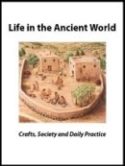Unless you are in a zoo, you are unlikely to spot an elephant roaming around Israel today. Prehistoric Israel, however, was a different story. Many remains of elephants and other animals, no longer indigenous to the southern Levant, have been found over the years. One of the most interesting discoveries is an 8-foot-long elephant tusk uncovered in southern Israel by the Israel Antiquities Authority (IAA), along with Tel Aviv University and Ben-Gurion University. According to the team, the tusk dates to the Lower Paleolithic Period, around half a million years ago.

When Elephants Roamed Israel
The ancient tusk was discovered in the area of Revadim in southern Israel. The area had been previously studied by IAA archaeologists, who found stone tools as well as animal bones. “But finding this half a million-year-old complete elephant tusk in such a good condition is something else,” said excavation director Avi Levy. “This is the largest complete fossil tusk ever found at a prehistoric site in Israel or the Near East.” The tusk belonged to a species known as the straight-tusked elephant, which roamed the region from 800,000 to 400,000 years ago and was much larger than the modern African Elephant.

An archaeologist from the IAA, uncovering the prehistoric tusk in southern Israel. Courtesy Yoli Schwartz, Israel Antiquities Authority.
Although no longer indigenous to the southern Levant, many large mammals roamed the hills and plains of Israel in prehistory and up to antiquity. These included hippopotami, wild horses, bears, lions, and largest of all, elephants. Excavations have shown that despite their size, these massive animals were sometimes hunted. “The concentration of the material remains—mostly stone tools—in the current excavation and at the entire site, indicates that there was a substantial number of people at the site in one period of time and that elephants were hunted. In the hot dry climate in our region, elephant’s meat could not stay fresh for long, so it must have been consumed quickly by many people, probably as part of a communal event,” said Professor Israel Hershkovitz of Tel Aviv University and Dr. Omry Barzilai of the IAA.
The tusk was discovered by accident by Dr. Eitan Mor, a biologist from Jerusalem, who visited the site out of curiosity, knowing of the large number of prehistoric finds uncovered nearby. While walking around the area, he spotted a small section of the tusk sticking out of the ground. Realizing what he found, Mor immediately contacted the IAA. This is certainly not the first time such incredibly large fossils have been found by accident. Some scholars have suggested that the discovery of ancient fossils could be at the heart of many myths about giants found in the stories and mythologies of classical and biblical literature.
Given its age, the tusk was very difficult to excavate. “The fossilized tusk is extremely fragile, and it is likely to disintegrate when exposed to the air and sunlight, and to human touch,” explained Hershkovitz. After it is preserved and analyzed, the tusk will likely go on display in the National Campus for the Archaeology of Israel, which is currently under construction in Jerusalem.
Related reading in Bible History Daily:
The Prehistoric Diet and the Rise of Complex Societies
Neolithic Figurine Could Lead to Reassessment of Prehistoric Israel
The Ancient Bean Diet: Fava Beans Favored in Prehistoric Israel
The post Hunting Elephants in Prehistoric Israel appeared first on Biblical Archaeology Society.


0 Commentaires